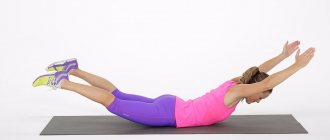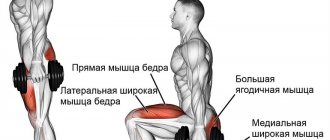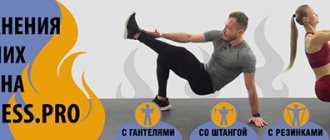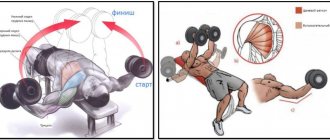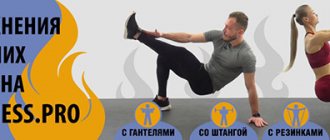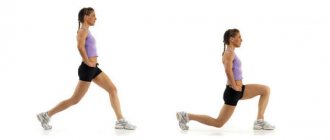Categories
- Workouts for weight loss
- Proper nutrition
- Weight loss
- Health
- Motivation
- Beauty secrets
- Video
About a beautiful, flat stomach
Almost everyone dreams of a slim figure.
But
achieving the desired result
is not
as easy as we would like.
There are many prescriptions for achieving the ideal. Vacuum exercises for a flat stomach
are recognized as one of the most effective.
Exercise technique
successfully combines stress on
the abdominal muscles
and
breathing
.
Such training is aimed at strengthening the internal
transverse and deep
muscles,
as well as enriching the body with oxygen.
As a result of regular training
, you will get a perfectly flat
stomach
, straight
back
and royal posture.
How does a belly vacuum work?
The essence of training
focuses on a breathing exercise that directly targets the transverse
abdominis muscles
.
In other words, isometric muscle contraction occurs .
This will help tighten the transverse
muscles
, and the external appearance
of the stomach
becomes flat and firm.
At the same time, the vacuum
helps get rid of visceral abdominal fat, cellulite on the stomach and restore elasticity to the skin.
To achieve the desired effect, you need to
perform the exercise
constantly, at least five times a week, twice a day.
What is a belly vacuum
The weight loss vacuum seems simple to perform - you just need to pull in your stomach, but this ease is illusory. The work technique is quite complex, but perseverance and self-discipline will help you overcome all difficulties. The effectiveness of the vacuum method is not inferior to the famous “plank”, crunches and other popular approaches to losing weight. The technique is suitable for both men and women, beginners and professionals.
Abdominal vacuum
The vacuum method gives physical stress to the abdominal muscles, and enriches the entire body with oxygen. Both athletes, ordinary people, and scientists agree that this system is very effective, reviews about it are mostly positive.
Interesting fact! Vacuum breathing for weight loss is based on the yoga system and is very similar in its mechanism of action to “Uddiyana bandhi,” which means “abdominal lock.”
How does the vacuum method differ from conventional pumping of the press? The point is that here muscle gymnastics and massage of internal organs are combined very harmoniously. Physical activity helps strengthen the rectus and oblique muscles, which are located closer to the surface, creating relief. Vacuum works differently - it allows you to train the internal transverse and hidden muscles of the multifidus type. As a result, you can not only become the owner of a pumped-up body, but also get a beautiful curve of your back, a flat stomach, and make your posture more graceful.
On a note. The main work is done by the transverse muscle - the so-called weightlifter's belt. This muscle serves as a support for internal organs. Vacuum breathing helps burn fat on the sides and waist. Tissue cells receive additional oxygen, which serves as fuel for the breakdown of fats and the recovery process.
The result of regular vacuum breathing can be a significant improvement in the condition of various organs and systems:
- Digestion will improve, all substances will be better absorbed and enter the blood more efficiently;
- the condition of the liver will improve, toxins will be eliminated faster;
- immunity will be strengthened, cell activity will increase;
- the nervous system stabilizes, the person becomes calmer;
- weight loss, especially in combination with proper nutrition.
One example of a successful result from using the technique is an exercise that is advertised by Arnold Schwarzenegger, a Hollywood actor and bodybuilder. He became famous in the sports community as a master of vacuum technology.
Recommendations for Beginners
There are several simple rules that will help beginners quickly and, most importantly, correctly, master the technique of vacuum exercises for the abdomen.
- Start in the morning, before your first meal. Repeat the exercise in the evening before bed, on an empty stomach.
- You need to inhale and draw in your stomach at the same time. Hold the position for 15 to 30 seconds
. As much as you can for the first time. - The simplest and most understandable exercise for beginners is considered to be in a lying
.
This makes it much easier to pull your stomach in as much as possible and control the breathing process. With experience, you can move on to practicing standing, sitting and on all fours.
Vacuum gymnastics is suitable for women and men who want to get their body and health in order. Exercises will help tighten muscle tone and eliminate a hanging or protruding belly
and, as a bonus, the vacuum massages the internal organs, which will help them stay in place and
not
“sag.”
Exercise also has a positive effect on waist
. Overweight people who dream of losing weight should definitely master breathing exercises.
How to properly perform the abdominal vacuum exercise
It is very easy to make this exercise an integral part of your life and achieve results quickly, but you must follow the basics of proper nutrition and not overeat. The effectiveness of a vacuum is characterized by several rules that will speed up the result.
- Do the exercise first thing in the morning.
- The duration of the vacuum inhalation should be at least fifteen seconds.
- Before performing, you should neither drink nor eat.
As with any other exercise, it is very important to monitor your breathing. Before performing, you need to completely empty your lungs of air. To perform it correctly, after releasing the lungs, you need to pull in your stomach as much as possible so that it practically sticks to the walls of the spine. At the same time, you may feel slight pain, this means that there are inflammatory processes inside and here you need to seek help from a doctor. Or see if the pain disappears over the course of several sessions - perhaps there is no reason to worry.
There are several options for performing a vacuum for the abdomen, but they are all equally effective:
- Lying on your back with your knees bent. Perhaps this is the easiest way to start with.
- In doggy pose. To do this, you should kneel down and pull your stomach to your back as much as possible.
- Standing. This is the most suitable option if you want to check the correctness of the technique. To do this, stand in front of the mirror and start doing it.
It is worth noting that this exercise perfectly stimulates the intestines and will help normalize stool.
How to do a stomach vacuum correctly. Step by step description.
There are several techniques for performing the exercise:
Lying position
The basic version of the exercise is considered to be in a lying position.
- You need
to lie on your back, straighten your shoulders and back, stretch your arms along your body, press your lower back to the floor, bend your legs at the knees. - Inhale
through your nose and exhale as much as possible through your mouth. - At the same time as you sigh, draw in your stomach as much as you can.
- Without
leaving the position, hold your breath and hold for up to 30
seconds
.
It will be difficult at first, but
even with short sips of air you need to continue to keep your abdominal muscles retracted. - You should exhale slowly, without sudden muscle relaxation.
- Inhale and exhale several times as usual and start again. To begin with, 3-4 repetitions are enough until get
the hang of it and
learn
how to do everything correctly.
All fours position
When you learn how to perform a vacuum while lying down, you can try the strength from a position on all fours.
- Get on all fours, keep your head and neck parallel to the floor, keep your legs and body at right angles, and keep your hands exactly shoulder-width apart.
- The breathing technique is the same as in a lying position: inhale through the nose and at the same time draw in the stomach as much as possible, exhale through the mouth and hold the position for as long as possible.
- After performing, without
leaving the position, take a few regular breaths and repeat the exercise several more times.
Sitting position
One of the most “mobile” ways to train is in a sitting position. It can be done
both at work and on public transport.
- Sit up straight, keep your back straight, place your legs strictly at right angles. Press your feet firmly to the floor. Under no circumstances should you lean your back against a wall or the back of a chair during the exercise. We keep everything ourselves.
- Another way of vacuum training is sitting on your knees. You need to
kneel down, lower your pelvis onto your heels, keep your back straight, and place your hands on your knees.
When inhaling and drawing in your stomach
, also slightly round your back and maintain the position until you exhale completely. - breathing
technique as in
the lying position
with a slight adjustment.
As you exhale while tightening your abdomen
, it is permissible to slightly round your back,
but
without fanaticism. We also hold our breath and posture, then exhale completely and perform a few more approaches.
Standing position
And a vacuum exercise for the abdomen in a standing
. It is considered the most productive precisely for achieving an ideal figure.
There are two positions for performing a standing
.
- You need to stand straight, arms along your body, feet shoulder-width apart. Don't
your body . - Tilt your body slightly forward, place your feet shoulder-width apart, bend your knees halfway, and rest your hands on your knees.
And then we begin the breathing exercise exactly according to the same principle as in the original version while lying down.
Each and technician is easily accessible to perform at home and not
Requires no sports equipment. Comfortable clothes, a positive attitude and perseverance.
Types of vacuum technology
You can practice standing, lying down, sitting and from the “on all fours” position. The last option is considered the most difficult, however, reviews of vacuum exercises for the abdomen from this position are the most positive - this is a very effective position that gives maximum load and a surge of strength.
Vacuum from a standing position
Standing abdominal vacuum
To perform breathing correctly, you need to place your feet shoulder-width apart, straighten your back, and place your hands on your hips:
- Take a deep breath through your nose, drawing in as much air as possible.
- Then they exhale sharply through the mouth, trying to push out all the air, while simultaneously drawing in the stomach towards the spine.
- Hold your breath for 5-40 seconds depending on your level of training.
- They relax and allow oxygen to freely penetrate the body.
You can bend slightly and rest your hands on your bent knees.
Vacuum breathing from a lying position
Technique for performing from a lying position
They begin to breathe, sitting comfortably on a flat, hard surface:
- Legs are bent at the knees, hands are placed on the hips.
- Inhale slowly, then exhale equally slowly through the mouth, freeing the lungs and abdominal cavity from air.
- The abdominal muscles are pulled towards the spine, straining the abdominal wall.
- Hold the position for 10-15 seconds without relaxing the muscles. Then slowly inhale until the lungs are filled with oxygen again.
It is easiest to perform the vacuum technique while lying down, but the technique differs from other starting positions.
Vacuum from a position on a chair
Sitting on a chair, they begin to breathe as if they were standing. The back should be as straight and relaxed as possible. Hands rest on the armrests or knees. Inhale through the nose, exhale through the mouth. The head should be parallel to the floor.
Vacuum breathing technique on all fours
Doing the exercise on all fours
Get on all fours, aligning your back relative to the floor. The hands should be strictly under the shoulder joints. Knees – strictly under the hip joints. Start breathing:
- When air enters through the nose, the back is slightly arched.
- As you exhale, you begin to round your back, lowering your head and spreading your shoulder blades.
- Then they gradually return to the starting position.
The position on all fours actively affects the muscles of the back and lower back.
Danger, contraindications, harm
Pros of vacuum exercises
many,
but
there are also certain
contraindications
.
It is not
recommended for pregnant women or girls during their menstrual cycle to do abdominal vacuuming
Exercises for diseases of the abdominal
- fibroids, cysts, polyps, gastritis, uterine prolapse, endometriosis, hernia (including umbilical), hemorrhoids.
Also, it is strictly forbidden to perform vacuum exercises
for people who have recently undergone surgery. For your own peace of mind and confidence, before starting exercises, it is better to consult a doctor.
Exercises are not
recommended during the postpartum period.
There is a myth that
you can start using
a vacuum almost
on the second day after birth.
It's a delusion. If you do the exercise on the second or third day, there is a risk of developing inflammatory processes in the uterus. You should begin to restore your figure no
earlier than 6-8 weeks after the birth of the child.
Vacuum for the stomach
It can also be performed for diastasis,
but
only on the recommendation of a doctor and in combination with other exercises.
Before and after results
Reviews
Victoria Akulina, 29 years old.
In the wake of the popularity of this exercise, I also decided to try it. I can say that there is definitely an effect. nutrition also plays an important role.
and Pilates. I do the abdominal vacuum as an additional and easy workout. And I'm happy with myself. I regained my figure after childbirth and am successfully maintaining the result.
Irina Sievert, 24 years old.
I’ve been doing vacuum training for a long time and I can’t
I can on them.
I
never chubby, but my stomach always remained “fat” in one way or another.
I started practicing a vacuum for the abdomen and the visual effect appeared within a month. Of course, in addition to this, I did traditional abdominal exercises and monitored my diet. But
what I especially like about the vacuum is
that it’s
very convenient. During the day you can train your muscles, even in the office, even at the bus stop, even while shopping. Now I’m proud of my flat tummy and wear tight dresses without any complexes.
Natalya Verchenko, 32 years old.
I've been practicing the exercises for several months and really like it. Not
Everything worked out right away, it’s difficult to control and strain the muscles and monitor breathing,
but
I got used to it within a week.
Now I practice either lying down or standing. And there is a result - the skin tightened, the waist
decreased by 2 centimeters and even the functioning of the intestines normalized.
Types and features of exercise
The vacuum can be done lying down, on your knees, sitting or standing. You can alternately apply one or another work tactic and achieve the desired results. What are the features of each type of exercise?
Vacuum standing
First of all, you need to take the most comfortable position. After this, follow this technique: at the entrance, strongly draw in your stomach and hold in this position for as long as possible. There is no need to make any special time restrictions; with each new time you can slightly increase the time of the vacuum exercise.
Interestingly, a vacuum in this position can be performed at any convenient time. But a particularly important point is control of the abdominal muscles. Experts recommend constantly drawing in your stomach, regardless of what work is being done and what position the person is in. Such actions will help tone the transverse muscle, and such tension will become familiar to it.
Vacuum lying
This is the position for performing this exercise that is most comfortable for those who are just trying to master the vacuum technique. The ideal option would be to lie on a hard surface and bend your knees.
After this, you need to place your hands along your body and take a very deep breath. Then slowly exhale to the full limit, while you need to draw in your stomach with effort. Experts sometimes advise beginners to imagine that they need to touch the spine with their navel and press it with such force. You need to stay in this position for about 15 seconds. It is allowed to take small breaths during the exercise.
How many times should you do this exercise per day? Athletes advise that you need to do at least 3-4 approaches at a time, and return to the vacuum exercise about twice a day.
It is very important not to overeat before such transverse muscle training. It will be quite effective after waking up on an empty stomach. But over time, after the body gets used to certain loads, you can increase the time for the exercise from 15 seconds to a minute. But the most important thing is to feel comfortable during training and not cause harm to your health.
Features of the vacuum on the knees
Experts recommend moving on to this type of exercise after the lying vacuum has been mastered. If during a lying position a person is affected by gravity, which helps him in training, then in a position on all fours he will have to counteract it, which makes training a little more difficult.
To perform the exercise, you need to kneel and place your hands on the floor, but you are not allowed to bend your arms. After this, you need to take a deep breath, to the “maximum”, and then come out and strongly pull your stomach in. Then lower your head a little and arch your back so that it resembles an arc shape.
This exercise should initially last about 30 seconds, but over time you can increase its duration to a minute or more. Moreover, it must be taken into account that there should be approximately 5 such approaches at a time.
Vacuum sitting
It is in a sitting position that it is quite difficult to perform such an exercise, since gravity will not help the person, and also the muscles that keep the spine in a straight position will complicate the training.
To carry out this type of exercise, you need a net on a hard surface, and you are not allowed to rest your back against anything. After this, a very deep breath is taken again, then exhale and the stomach is drawn in with it. You need to stay in this position for about a minute. If there is not enough breathing, then you are allowed to take small breaths.
Reviews from doctors and specialists
Frequently asked questions and answers
Does your stomach hurt during a vacuum?
There should be no painful sensations when performing the vacuum exercise. If you feel discomfort and pain, you should consult a doctor.
Can't hold your breath for a long time?
Hold your breath a little at a time. Start for 10-15 seconds, but do not 5, but 7 repetitions, for example. And so on incrementally until you and your body get used to it.
How soon can I start eating?
After exercise, the body needs a break. In the morning it is acceptable to start breakfast after 30 minutes, but in the evening it is better to wait an hour. If you had dinner before evening practice, then wait 2-3 hours. By the way, you can drink water immediately after training, but not cold or hot, only warm.
How many times a day should you do the exercise?
Twice a day, morning and evening, 5 sets, 5 days a week. As you get used to it, you can increase the load.
Does a vacuum remove belly fat?
Vacuum is not a panacea, but a good aid. If you are determined to lose weight and improve your body
— a set of actions is required.
Proper nutrition, additional physical activity and vacuum. This
exercise targets the internal abdominal muscles and helps burn visceral and internal fat.
Abdominal vacuum: exercise technique
The technical performance is very difficult to describe in words, but we will try and think that with regular training you can achieve an ideal result. However, we recommend that you watch video tutorials on vacuum before proceeding.
- After you take a position that is comfortable for you, based on the method of execution, take a deep breath through your nose, and then exhale sharply through your mouth.
- After you have completely emptied your lungs, you need to hold your breath.
- While in this state, with a sharp movement, press your tummy to the walls of the spine.
- Record this process for at least fifteen seconds.
- After this, exhale slowly and repeat a few more times.
Remember that regularity and even dailyness are required here. And also do not forget about the number of approaches - there should be at least five. After completion, you should not drink or eat food for at least twenty minutes.


